Land's Sodium Light Viewer
A few years after moving to the San Francisco Bay area, I discovered the Exploratorium, a collection of science exhibits housed in the building that had been the Palace of Fine Arts during the 1915 Panama-Pacific Exposition. One of the exhibits was particularly interesting to me: It was a demonstration of the Edwin Land's sodium-light viewer, and it was both simple and profound.
From a distance, the sodium-light viewer looked like a large box sitting on a frame so that it was at eye level. The room light was dim, and a yellowish glow shone from a cutaway corner of the box. Closer inspection revealed that the cutaway portion of the box held two large black-and-white transparencies mounted at right angles. One was lighted from behind by a white light, the other by a yellow sodium-vapor light.
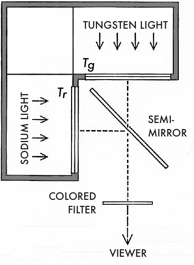
This diagram shows the design of the box, which was opaque except for the two windows holding the transparencies, labeled Tr and Tg.
Bisecting the right angle made by the transparencies was a half-silvered mirror positioned so that when you looked at one of the transparencies through the mirror you saw the reflection of the other superimposed on it. Both transparencies were made from the same photograph of a collection of colored objects and were aligned so that they appeared in register.
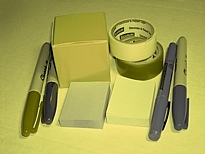 Since the black-and-white transparencies were illuminated with white light and yellow light, the only colors I saw in the image were shades of yellow and gray.
Since the black-and-white transparencies were illuminated with white light and yellow light, the only colors I saw in the image were shades of yellow and gray.
So far, so boring, but we're about to get to the good part.
Lying in the open portion of the box were two colored glass filters, one deep red, the other deep green. A label on the box invited the viewer to pick up one of the filters and look through it at the composite image in the mirror. 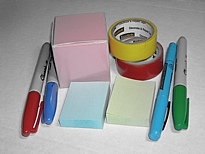 When I looked through the green filter, I saw something surprising and deeply satisfying: The composite image now appeared in full color (though the colors were a bit subdued).
When I looked through the green filter, I saw something surprising and deeply satisfying: The composite image now appeared in full color (though the colors were a bit subdued).
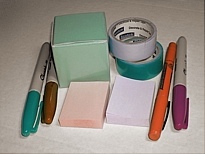 When I picked up the red filter and looked through it, something even more wonderful happened. The image was in full color, as before, but the colors were reversed— each was replaced by its complement.
When I picked up the red filter and looked through it, something even more wonderful happened. The image was in full color, as before, but the colors were reversed— each was replaced by its complement.
The effects of this exhibit seemed magical, but the magic is in the way the human visual system works.
The two black-and-white transparencies were pictures of the same scene, but one (Tr) was made through a red filter and the other (Tg) through a green filter. When I looked through my green filter at the combined image in the mirror, only the green portion of the white light coming through transparency Tg was visible. The yellow sodium light illuminating the other transparency still appeared yellow. (The sodium light is monochromatic: A filter can either pass it or block it, but cannot change its color.)
The next two pictures compare the way you would expect that image to look — the way it would look to a camera — with the way it actually looked to me. Apparently my visual system was completely compensating for the greenish cast of the image.
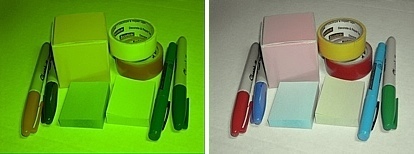
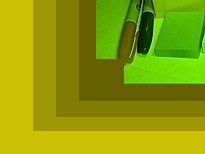
Even though the pen on the left in the camera's image looks reddish, no part of that image is actually red. This picture shows the pen's color expanded and lightened; as you can see, the color that maps to red in the perceived image is a dark shade of yellow.
When I looked through the red filter, only the red portion of the white light came through. The sodium-light still appeared yellow, but this time it was the shortest wavelength, where before it had been the longest wavelength; that's why all the colors appeared reversed.
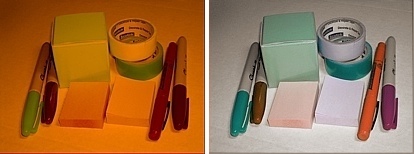
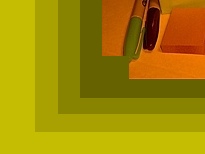
As before, here's a comparison of a camera's view of the image with the way the image looked to me. This time the yellow sodium light is the shortest wavelength in the image. The pen on the left in the camera's image may look bluish, but no part of that image is actually blue. As in the previous example, this picture shows the pen's actual color — a dark shade of yellow.
With the small pictures shown here, the colors are only somewhat affected by their surroundings. For the exhibit at the Exploratorium, the room light was dim and my field of view was dominated by the image in the box, so it alone determined my perceptions of the colors in the image.
According to the conventional explanation of color vision, our perception of blue is stimulated by light with the shortest visible wavelengths, around 425 nanometers. Green corresponds to wavelengths around 500nm, yellow to 560nm, and red to 700nm, as shown here.

As the Land experiments demonstrate, the colors we perceive correspond to the colors in the spectrum only when the scene is lighted by balanced, full spectrum light. When the lighting is other than normal, such as artificial light, sunsets, and the like, our visual system tries to correct for the unusual lighting in order to show the colors of objects as they actually are.
Land's sodium-light viewer shows how extreme the disparity between stimulus and perception can be. With the green filter, there is no red light in the image; with the red filter, there's no blue. Yet, in either case, we perceive the full gamut of colors from blue through yellow to red.
Full disclosure: Photographic film and video cameras record colors based strictly on the spectrum, so the color perceptions produced by this exhibit cannot be reproduced photographically; I faked these illustrations using Pixelmator. Similarly, Land's 1959 article included pictures that had been colorized to resemble the images perceived by the people viewing the experiments.
You can find a PDF file of the Land article here.
This link takes you to my earlier Land-effect article.
[X] Close this window.
Last updated on 5/25/2014
Copyright © Allen Watson III